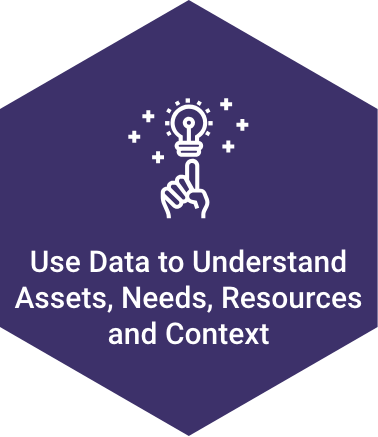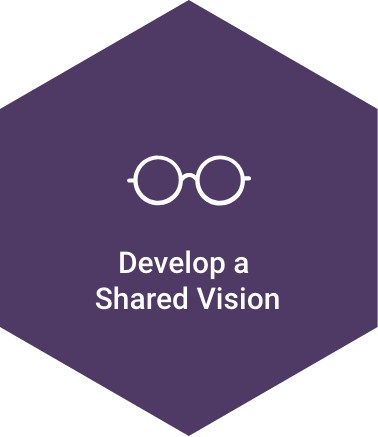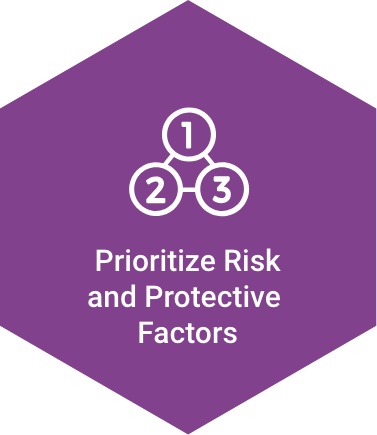-
Use Data to Understand Assets, Needs, Resources, and Context
-
A public health approach uses data to make decisions and set priorities. Using the best available data can help you understand the problem and determine your group’s ability to address violence. Different types of community assessments can give a clear picture of a community’s priorities, needs, resources, and health inequities. Data may come from a range of sources including public meetings, focus groups, surveys, and publicly available data sources.
Here are some common methods for gathering information on community needs, assets, resources, and context:
- Needs Assessment is a process to identify comprehensive information about the community’s current health status, needs, and issues. Conducted in collaboration with key stakeholders, it helps to identify community priorities.
- Asset Mapping identifies assets that improve quality of life in a community. These can help you identify supports, resources, structures, and other strengths.
- An Environmental Scan helps examine how the organizational, social, economic, cultural, and political context affects the ability and commitment to address violence. This includes a review of existing policies, practices, and programs in the community, including their impact and strengths and weaknesses. Consider examining how the current strategies and approaches in your community map onto the strategies and approaches in the Resources for Action.
- Capacity Assessments determine whether you and your partners are able to affect various factors for violence and implement certain strategies and approaches.
Learn more about all of the assessments described above.
Planning: Set Yourself Up for Success
Developing a comprehensive plan before you embark on the work should increase your chances of success. This section can help you create a comprehensive plan or specific plans for implementation/action and evaluation. Use the Tools, Resources, and Tip Sheets related to Planning at the beginning of a process or along the way.
To identify and coordinate key organizations and people to participate in the planning process,
Go to Partnerships- Develop a Shared Vision
-
Vision statements provide purpose and direction for planning. They describe what the ideal future looks like from the group’s perspective. A vision statement can help you set goals that align with the group’s values and desired outcomes. Refer back to the vision statement throughout the planning process to clarify the group’s thinking and keep stakeholders engaged in the process.
For ideas on selecting stakeholders to participate in this process, see the Partnerships Section.
- Prioritize Risk and Protective Factors for Violence
-
To have a broad and sustained impact on violence, it is critical that your plan targets multiple risk and protective factors, especially for the populations or places that are most affected. You cannot address all the factors and every community is unique. It is important to determine which factors are contributing to violence and related problems in your community, and address those first.
Some protective factors for one form of violence may protect us from other forms of violence. Connecting the Dots: An Overview of the Links Among Multiple Forms of Violence identifies these, and looks at the risk factors that make multiple forms of violence more likely.
For more information on risk and protective factors related to specific types of violence, visit the following sites:
Shared Protective Factors
- Coordination of resources and services among community agencies
- Access to mental health and substance abuse services
- Community connectedness
- Family support/connectedness
- Connection to a caring adult
- Association with pro-social peers
- Connection/commitment to school
- Skills in solving problems non-violently
Shared Risk Factors
- Cultural norms that support aggression toward others
- Media violence
- Harmful norms around masculinity and femininity
- Societal income inequity
- Neighborhood poverty
- Diminished economic opportunities/high unemployment rates
- Economic stress
- Weak health, education, economic, and social policies/laws
- High alcohol outlet density
- Community violence
- Poor neighborhood support and cohesion
- Social isolation/Lack of social support
- Poor parent-child relationships
- Family conflict
- Associating with delinquent peers
- Gang involvement
- Low education achievement
- Lack of non-violent social problem-solving skills
- Poor behavioral control/impulsiveness
- History of violent victimization
- Witnessing violence
- Psychological/mental health problems
- Substance use
Risk and protective factors interact to affect the likelihood of violence. No single strategy or approach on its own will significantly reduce violence. Your plan should be comprehensive and include a variety of strategies and approaches that addresses several factors at once.
Consider these questions when prioritizing risk and protective factors:
- What are the risk factors in the population or community most affected by violence? What are the protective factors that may buffer the risk of violence in this specific population or community where the work will occur? Consider focusing on places with inequities related to socioeconomic status, race and gender, and other groups that may be disproportionately affected by violence.
- How much does this risk or protective factor contribute to violence in your community? To what degree does it protect against violence? Is this factor relevant?
- How important is this factor to the community? Is this factor associated with other pressing problems in the community?
- Are you, with the community and your key partners, able to influence this factor, given the available resources, readiness, and timeframe?
For more information about shared risk and protective factors,
To help the planning group hone in on the most salient risk and protective factors, download:
- Write the Plan
-
A written plan is an ongoing reference document for the implementation and evaluation phase. All stakeholders and partners should have a common understanding of the goals and action steps. Summarize the planning process in a strategic plan, an action plan, or a logic model. This document should explain what you are trying to do and why you think it will work as intended to reduce violence. It could also describe the roles of various partners and identify ways you will measure progress toward your goals.






